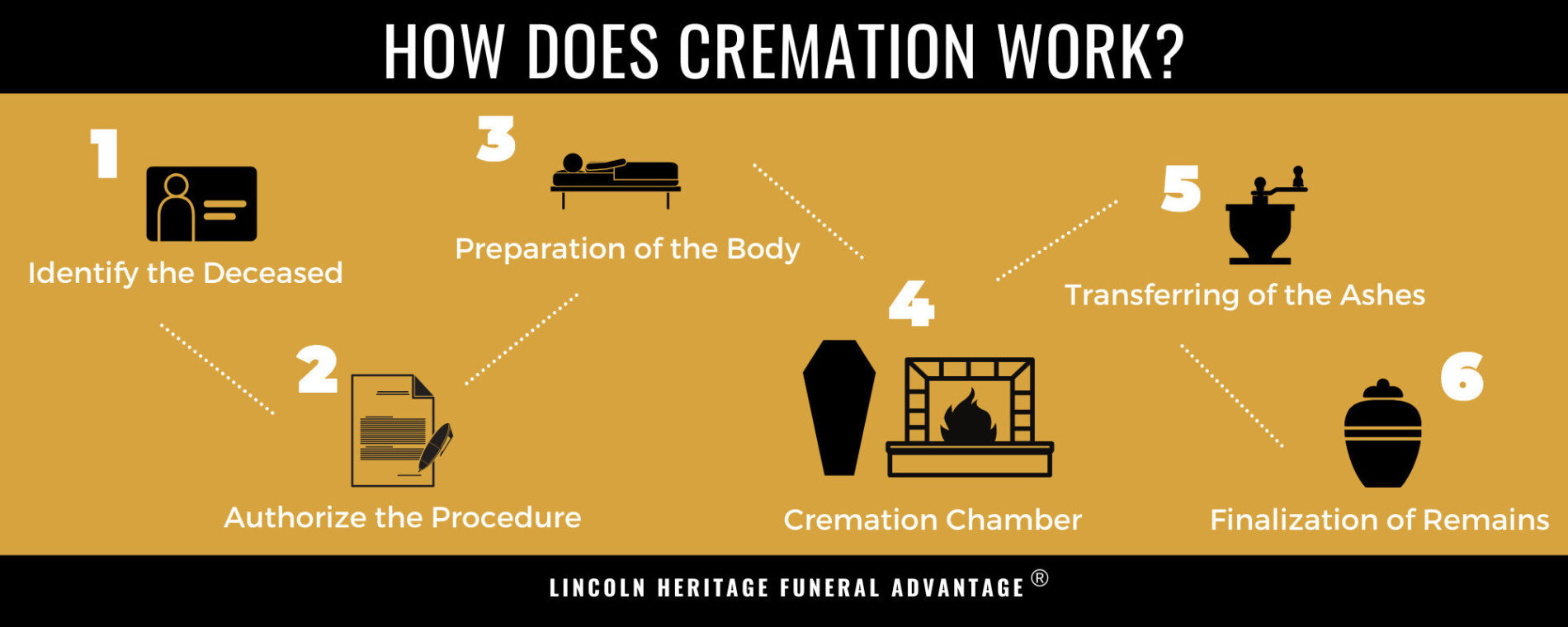How does cremation work? Exploring the Process from Start to Finish
The practice of cremation has become as common as “traditional” burial in the United States. In fact, today, more than half of Americans choose cremation. By 2035, the National Funeral Directors Association estimates this figure will top 78 percent.
Why do people decide on cremation?
This rise in cremation procedures is a result of factors such as:
- Reduced religious affiliation: Less than 40% of Americans today choose a religious funeral.
- Growing environmental awareness: Many opt for cremation to reduce land usage, preserve natural resources like hardwood, and avoid chemicals associated with the embalming process.
- Lower cost: Cremation is less expensive than a burial and still allows families to hold a traditional service.
- More personalization: More choices in storing or scattering the remains offers meaningful options that better represent the deceased.
- Flexible timing: Burials typically require prompt attention, while cremation allows time for the family to gather (if spread out across the country or around the world) and make final arrangements if the deceased did not pre-plan.
The following article will cover the process of cremation and provide considerations that can help you decide if it’s the right choice for you and your family.
Table of Contents
What is the cremation process and how does it work?
Depending on your location and the services performed, cremation can range from $1,000 – $3,000 on the low end of the spectrum but can cost as much as $6,000 – $8,000. Having a traditional service beforehand can significantly increase your costs, particularly if there is a viewing or if a casket is needed.

Step 1. Identifying the Deceased
Identification regulations vary from state to state. The individual facility defines its specific procedures based on industry recommendations, but identification typically involves a family member confirming the identity. Upon confirmation, a metal ID tag is placed on the body, which will remain throughout the process and then be put with the remains for final verification.
Step 2. Authorizing the Procedure
The crematory must have official permission to move forward with the cremation. Most require that the person(s) making the final arrangements completes paperwork that authorizes the crematory to proceed. (Remember that each state has its own rules about who is legally allowed to make these decisions.) The paperwork also asks for information regarding the type of container the crematory should use and who will be responsible for picking up the remains.
Step 3. Preparing the Body
Preparing the body is something the individual facility can handle in its own way but usually involves cleaning and dressing. For typical cremation, the body is not embalmed unless the beneficiaries request this for a public viewing or other personal reason. Jewelry or other items are taken off for the loved ones to keep, except those requested to stay with the body, and medical devices and prosthetics that are mechanical or battery-operated are removed to avoid a reaction. Finally, the body is placed in a vessel that is combustible yet strong enough to hold the weight.
Step 4. Moving into the Cremation Chamber
The cremation then takes place in a specially designed furnace, referred to as a cremation chamber or retort, and exposed to extreme temperatures – up to 1,800 degrees Fahrenheit – leaving behind only ashes. Following the procedure, a cooling period is required before the remains can be handled.
Step 5. Finalizing the Remains
After cremation, the remains are inspected for any metal remnants left behind. This can be the result of items such as pins, screws, and joints the deceased had surgically placed during life. Metal is removed by hand or with strong magnets, and then it is often sent for recycling. The cremated remains are then ground down by a special processor into the final resulting ashes.
Step 6. Transferring the Ashes
Unless specified otherwise, the remains are placed in an urn (or another container) and returned to the family.
How Long Is the Process?
Cremation is considered more efficient than traditional burials and can be completed in a shorter amount of time following a death. Depending on factors like the size and weight of the body, the type of container holding the body, and the efficiency of the equipment installed, the actual cremation procedure usually takes between 2-3 hours for flame-based processes and up to 16 hours for liquid cremation (see below).
Keep in mind the crematory has its own policies on how long it can take to have the remains ready for the bereaved. Seven to ten days is not an unusual turnaround time, and it all depends on the individual facility’s policies and procedures.
What Is a Cremation Chamber or Crematorium?
A cremation chamber, also known as a retort, is an industrial furnace designed to hold one body. Lined with fire-resistant bricks, the chamber can withstand temperatures up to 2,000 degrees. Modern cremation furnaces are automated and computerized, and they are fueled with natural gas, propane, or diesel. They must follow today’s environmental and air quality standards.
A crematorium is usually the term for the facility that houses a cremation chamber or retort. There may be multiple chambers in a crematorium. A crematorium can be a part of a funeral home, a church, or it can be a stand-alone facility. Crematoriums are usually regulated by the state.
Types of Cremation
Compared with traditional burial, cremation typically does not require embalming, and large burial plots are unnecessary. Cremation is also typically a less expensive arrangement than traditional burial.
There are a couple of different options for cremation.
Types of Cremation
| Direct Cremation | Liquid Cremation |
|---|---|
| Uses heat to reduce the body to bone fragments | Uses water and alkali to speed up decomposition |
| Flame potentially creates mercury byproduct | Flameless process consumes very little energy, and the resulting sterile solution can be recycled through the wastewater treatment system. |
| Smaller amount of resultant ashes | Larger amount of resultant ashes |
| Requires removal of metal, pacemaker, etc. | Many medical devices may be left in the body |
| Legal everywhere | Not yet accepted in all US states |
Direct Cremation
Direct cremation is a process where the remains are transferred directly to a cremation center without a funeral service beforehand. Because this approach eliminates the need for a funeral service and a casket purchase, it’s often the cheapest type of cremation. Direct cremations typically don’t allow for a viewing, visitation, or wake beforehand. Most families will schedule a memorial service at a later date for friends and family to pay their respects.
Liquid Cremation
The process of alkaline hydrolysis is an alternative to flame cremation. The combination of the water, alkali, heat, and pressure causes a reaction that speeds up decomposition and leaves behind only bone fragments and a sterile liquid. The flameless process results in about 30% more remains than flame-based cremation, which may require a larger vessel. This process may take three to sixteen hours, depending on body mass and equipment. Many medical devices, including pacemakers, do not need to be removed before the process as they do with conventional flame-based cremation.
Green Cremation
Alkaline hydrolysis is considered a “green” alternative to burial. Once drained of remaining bone fragments, the resulting sterile solution can be recycled through the wastewater treatment system. Many environmentally conscious individuals are now opting for alkaline hydrolysis instead of the conventional procedure because of its environmental benefits. In addition to the ability to recycle the liquid byproduct, it is a green choice for several important reasons:
- Green cremation reduces more than 75% of a body’s carbon footprint.
- The green process only consumes 1/8 of the amount of energy of conventional flame-based cremation.
- Because there is no flame, green cremation eliminates concerns regarding mercury emissions and reduces the use of fossil fuels and greenhouse gases.
Substituting Green Cremation for Conventional Cremation
To decide whether you can elect green cremation, you’ll first need to determine if your state permits the practice. Alkaline hydrolysis is still not approved nationwide. The process is regulated on a state level, and only about half the US states have legalized the process.

You’ll also want to contact your funeral home to find out their individual practices and policies. Even if your state allows alkaline hydrolysis, your funeral home might not be set up with the technology to perform it. If you discover that your state or facility does not support the procedure, you could consider reaching out to a provider in a neighboring state. One place to start is by doing a search for businesses classified as “Crematory, Alkaline Hydrolysis” on the Member Directory of the Cremation Association of North America.
The Body During the Cremation Process
The different types of cremation use different technologies to affect the body. In the “traditional” flame-based method, the body is placed into a cremation chamber that reduces the body to bone fragments using flame and heat. Combustion occurs in two stages: Primary combustion burns off tissue, organs, body fat, and some container materials as gases, then secondary combustion continues to work on the remaining inorganic particles, usually from the container. The gases (mostly mainly carbon dioxide and water vapor) discharge, leaving bone fragments to be pulverized into ashes.
For alkaline hydrolysis, the body is placed in a pressurized stainless steel chamber that combines 95% water and 5% alkali and raises the temperature to 350 degrees to speed up the natural process that a body undergoes after burial, which can take up to 25 years. The alkaline breaks up the chemical bonds in the body and converts them into basic chemicals of calcium phosphate from bone fragments and sterile liquid containing tissue remnants such as water, salts, and amino acids. The bone is then processed into ash, and the liquid is disposed into the wastewater system.
Frequently Asked Questions About the Cremation Process
What type of container is used for cremation?
While there are special caskets designed for cremation, the container can also be a simple cardboard box. The only requirements are that the container must be combustible, nontoxic, and sturdy enough to hold the weight of the body.
What type of container is used for the remains?
The crematorium will typically place the remains in a sealed, airtight bag or container. This can be placed inside virtually any receptacle. Just be sure to follow local burial regulations if you plan to bury the remains in the receptacle.
What happens to the remains after cremation?
The procedure allows for more personalized storage than a traditional burial. Cremated remains can be moved easily, so if the deceased’s family relocates, the deceased can also be relocated. Some choices include:
-
- Adding some of the remains to a special locket or piece of jewelry
- Placing the remains in a memorial bench, tree plot, or sculpture
- Converting the remains into a gem, similar to a diamond
- Scattering the ashes in a natural area that had meaning to the deceased
What are human ashes made of?
Cremated remains consist mostly of bone fragments, along with any residue left from the container or other associated results of the incineration.
How much ash is there after cremation?
Depending on the size of the body and the specific process used by the crematory, there are usually 3 to 9 pounds of remains.
Do bodies move during cremation?
If a body is burned at a low enough temperature and quickly after death, movements are possible. Because of the efficiency of modern cremation chambers, however, the body immediately begins its dissolution, and movement is unlikely.
Do you have clothes on when you're cremated?
Most crematories allow the bereaved the option of dressing their loved one prior to cremation (or having a funeral professional dress the body), although clothing choices must be completely combustible. This is especially the case when there is a viewing or other ceremony prior to cremation. For direct cremation with no viewing, the body is usually cremated in either a sheet or the clothing the deceased was wearing upon arrival.
Do they burn the coffin at a cremation?
Yes, the coffin (or whatever type of container selected to hold the body) is burned along with the body.
Do they cremate multiple bodies at once?
No, all cremations are performed individually. In the United States, multiple-body cremation is illegal.
What are religious views on cremation?
The views on cremation are as varied as the religions themselves. For many years, Christianity was opposed to cremation, although the past century has seen a greater acceptance of the practice. Even within Christianity, though, the practice is met with vastly different opinion: The Eastern Orthodox Church forbids cremation outright, while the American Episcopal Church has incorporated columbaria (public displays of cremation urns) into many parishes. Likewise, Orthodox Judaism remains opposed to cremation, while Reform Judaism has begun to allow it. Muslims are expressly forbidden from having themselves cremated or even participating in another’s cremation, while in contrast, Hinduism seems to encourage the practice.
Next steps
Although cremations are less costly than traditional burials, they still come with significant costs. If you are considering cremation for yourself or a loved one, it’s important to think about how you’ll pay for the procedure. One solution is final expense life insurance – also called burial insurance or funeral insurance. It’s specifically designed to help cover end-of-life expenses, like funeral and cremation costs.
If you’re still unsure about whether cremation is right for you, we’ve put together an article that compares the features of cremations and burials. You’ll be able to compare the costs, procedures, and various benefits of each type of service below.


